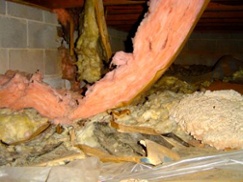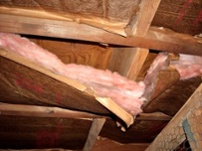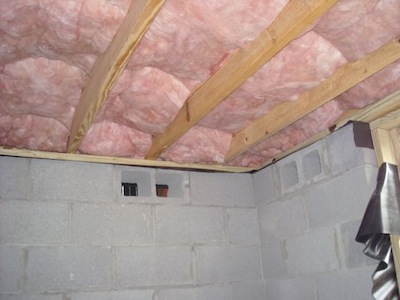3 Problems with Fiberglass Batt Insulation in Floors

I’ve been in a lot of crawl spaces and basements that have floors insulated with fiberglass batts. I’ve seen a lot of new homes that have fiberglass batts installed in bonus room floors, cantilevers, and floors over basements or crawl spaces. Not once have I ever seen one and said, now that’s how you insulate a floor!
I’ve been in a lot of crawl spaces and basements that have floors insulated with fiberglass batts. I’ve seen a lot of new homes that have fiberglass batts installed in bonus room floors, cantilevers, and floors over basements or crawl spaces. Not once have I ever seen one and said, now that’s how you insulate a floor!
Usually, I see one of these three problems:
- Fiberglass batts falling down (above photo)
- Fiberglass batts not in contact with subfloor (middle photo)
- Fiberglass batts compressed (bottom photo)
Pretty much any crawl space with fiberglass batts in the floor above will have the first problem. It may not happen right away, but gravity is patient. Even though it’s the weakest of the three fundamental forces of nature, it’s plenty strong enough to pull those batts down over time. And it’s relentless.
The second problem – batts not in  contact with the subfloor – is usually present as well. Sometimes it’s because the fiberglass batts aren’t supported enough, so it makes contact at the supports (called tiger’s teeth) but sags in between. Sometimes it’s because they’ve gradually fallen over time. Sometimes the installers never put the batts in contact with the subfloor because they didn’t understand its importance or it was too hard.
contact with the subfloor – is usually present as well. Sometimes it’s because the fiberglass batts aren’t supported enough, so it makes contact at the supports (called tiger’s teeth) but sags in between. Sometimes it’s because they’ve gradually fallen over time. Sometimes the installers never put the batts in contact with the subfloor because they didn’t understand its importance or it was too hard.
The third problem – compression – reduces the R-value of the insulation and is usually a result of the batts not being cut to the right size and not being fit properly around the obstructions (wires, pipes, ducts…). The photo below shows what is perhaps the best fiberglass batt installation I’ve ever seen in a floor system. It’s still not even a Grade II, though, with Grade I being the best and Grade III being the worst. As I wrote last month, Version 3 of the ENERGY STAR homes program requires Grade I installation (with the exception noted below).

So, why does this matter? Well, would you like to get in bed on a cold night with the blanket on the floor? Or suspended a foot above your body? Would you install a new fridge and never plug it in? Would you buy a new car and have the mechanic disconnect half of the pistons?
When you get fiberglass insulation with the problems described above, it’s the same. You’re getting a product that’s either completely ineffective, or it’s compromised. One of the fundamental principles of building science is that a house needs a complete and continuous building envelope, with insulation and an air barrier that are in contact with each other.
In the case of fiberglass batts in floors, as I said above, I’ve never seen a Grade I installation. It’s practically impossible to achieve, mainly because the tiger’s teeth that hold the batts up compress the insulation even when they’re otherwise installed perfectly, which they almost never are. Is it any wonder that the Green Curmudgeon suggested outlawing fiberglass batts?
Going back to ENERGY STAR Version 3, one of the new requirements is that insulation must be installed to Grade I or have continuous insulated sheathing and Grade II. I doubt builders are going to start installing foamboard on their floors, so that means framed floors have to be Grade I if they’re part of the building envelope. I think builders are going to have to rethink the material they use to insulate floors or, even better, try to eliminate framed floors from the building envelope in the design phase.
This Post Has 17 Comments
Comments are closed.

Hi Allison, I see this
Hi Allison, I see this problem almost daily. You stop short of making a recommendation though. In this climate zone, what do you recommend? Maybe you could tier your answer based on budget?
sounds like a job for spray
sounds like a job for spray foam . . .
Lance,&
Lance,
As Matt said, spray foam will do a good job insulating framed floors. Another would be to fill the cavity completely with blown fiberglass or cellulose, as long as you have some kind of rigid sheathing at the bottom to support it.
My favorite solution, though, is to eliminate framed floors from the building envelope as much as possible. With crawl spaces and basements, you do that by insulating the foundation walls instead of the floor above.
With bonus rooms, where you have conditioned space over a garage, you can’t include the garage inside the conditioned space, so you’d have to remove the garage from the house to use this strategy. Detached garages are better for indoor air quality, too.
Funny that you would mention
Funny that you would mention that. I have a situation I am bidding where the options are to spray-foam the sub-floor or the exterior basement walls / band. The benefit of the latter is that the ductwork would then be brought into the envelope that is currently in the unfinished basement. The problem is the Beacon software apparently does not recognize this improvement in their software and this is a GP HPwES opportunity.
All of the observations you
All of the observations you have made are true and I never see properly instally insulation, particuarly between floor trusses.I did notice that figure #2 has the vapor barrier toward the crawl space rather than against the heated space, which is also common.
Cheers
Encapsulating the floor
Encapsulating the floor system including duct work with Thermo-Cloth and closed cell spray foam insulation creates a “perfect wood framed floor system”.
The inside of the rim joist is sprayed from the sub floor to the bottom of the rim joist to drop the building envelope to the BOTTOM of the joists. Install the Thermo-Cloth and spray the foam to the cloth. We do 2 1/2 to 3 inches to create a R-19 rated complete air and moisture barrier under the house.
All wood is covered to the foundation an inch or two below the treated sill plate. This includes dropped girders.
Gas line connections and electrical junction boxes are dropped below the foam.
Now you basically have a floating dock. All air and moisture are shut off.
We have been doing this in coastal flood plain for about three years. It works well.
I have plenty of pictures, if anyone wants to see this process.
The cost difference in spraying the bottom of the sub flood and leaving the joists exposed to moisture and this method is the spraying of the rim joist and any dropped girders and/or duct work.
It works very well as a radient floor.
Thanks for highlighting this
Thanks for highlighting this problem. You might also mention the radiant coupling that can lead to mold on the joists:
http://www.buildingscience.com/documents/insights/bsi-009-new-light-in-crawlspaces?topic=resources/cond-crawlspaces
Also, you may want to recount the fundamental forces….
Mike,
Mike,
Mold needs three things to grow; food source, air, and moisture.
I guess you missed the part of this being a COMPLETE moisture barrier. Google the “perfect wall” and it also represents the “perfect floor”. The delta T for condensation to form gets greater as the humidity is reduced.
I can show you job after job that this system works.
What is the difference in a moisture barrier under a slab, or a moisture barrier under a floor system? NOTHING!!!
Think of a shoe box. We are having no problems with this system and 0% failures in a flood plain with elevations that vary between 6 and 21 MSL. We know humidity and understand air barriers. This is the perfect air barrrier for the bottom of the shoe box.
Understood. I was simply
Understood. I was simply pointing out another risk involved with this type of installation practice since perfection doesn’t always equate to the real world.
Bill,&
Bill,
Yeah, installers and building inspectors almost always get the direction of the vapor retarder wrong it seems. And if you’re in a mixed climate like Atlanta, it’s going to be wrong half of the year no matter where you put it.
Gene,
I like your idea of spraying the foam beneath, rather than between, the floor joists. It’s much easier to get in there and work on wiring, plumbing, and other mechanicals if you have to.
Mike,
That’s one of many great article by Joe Lstiburek. To make it easier for our readers to get there, I’m providing a direct link here:
New Light In Crawlspaces
Great Article! My 80 YO
Great Article! My 80 YO neighbor still doesn’t buy the idea. Quote: ” I don’t want an Energy Star – I want a warm floor.” Perhaps some day I’ll get through to her.
John Nicholas
But wait! There’s more! Don
But wait! There’s more! Don’t forget the rodent condos that almost always get built into the exposed fiberglass batts.
Homeowners don’t usually understand what those holes are, but the truth is revealed when the batt is pulled down and there is literally a shit-storm. Yuck. Indoor air quality, anyone?
As for the kraft-face backing, I’ve given up worrying about it’s up or down because there is no persuasive argument that it works either way.
And–oh yes–what happened to the fundamental concept that fiberglass batts need to be enclosed and sealed on six sides to perform properly?
Before moving to Arizona, I
Before moving to Arizona, I spent most of my life in the Carolinas, where crawl spaces are the norm. There was a definite market prejudice against slab-on-grade. Only production builders build on slabs.
I always hated crawls, so when I built my last house, I bought a sloped lot so I could build a walk-out basement with a tuck-in garage (master suite was above the garage). I used blown-in optima for the floor. It fills in nicely around all the interference. The only disadvantage is the additional volume (and cost) required to fill the joist spaces all the way to the netting. Still, this system costs less than foam and provides far more R-value than could ever be justified.
Here in the Southwest, virtually all homes are slab-on-grade, even at the high-end. Slabs are very efficient as long as edges are properly insulated. I guess the main disadvantage is the possibility of having to break concrete in the event of a drain problem.
Kraft facing must not be left
Kraft facing must not be left exposed. It burns and does not meet fire code. It must be in contact with a thermal barrier. Typical statement from manufacturer: “The kraft facing on this product will burn, and must not be left exposed. It must be covered with gypsum board or another approved interior finish”
Hi, reading with interest
Hi, reading with interest your comments on fiberglass insulation process. I have spent two days on my knees in our very nice crawl space putting up 6ml plastic from the sill plate down and across the floor, around four supports of cement blocks with 2 50X20 sheets of plastic. Overlapping for about 6 feet in the middle. Floor was very wet due to condensation dripping from the furnace/ac. I cleaned out the drain hose and re-positioned it for better drainage down two pieces of wood instead of the scallop I found as it hung from three wires attached to the floor joists. Anyway we have a huge stack of the fiberglass insulation sitting in our garage to install, then I read that it is worthless. I have not encountered any bugs, rodents or even spider webs. I am also putting in a ed-humidifier, but I really don’t want to go the sprayed insulation route. The walls are approx 5 cement blocks high. I really don’t want to have to take the fiberglass back to the store as I bought it in Dec 2013. I do have the tiger grips also. I have seen new housing being build with this. If it is run down the walls, paper side to the wall or crawl space?? Please reply. Thank you. Ava
Ava: If
Ava: If you’ve encapsulated the crawl space and air sealed to isolate it from outdoors, insulating the foundation walls would be a better strategy that insulation the floor. I know people who do that with fiberglass, but probably not the kind you have. A better option is to use foam board or spray foam on the foundation walls. See my pages on how to encapsulate a crawl space.
Insulating a crawl space,
Insulating a crawl space, what direction should the facing be placed? Up against the floor or facing down toward the cement?